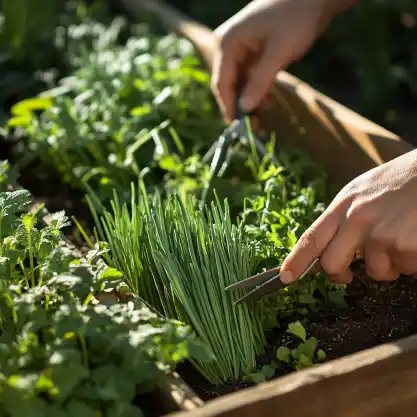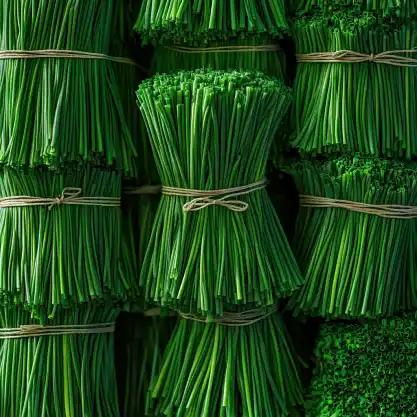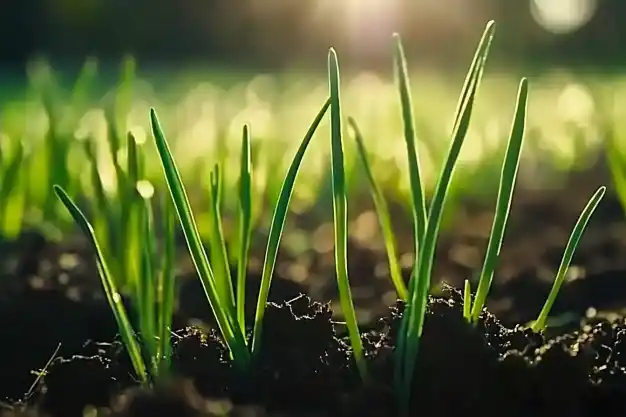Growing chives at home is an easy and rewarding way to add fresh flavor to your cooking. Chives are a versatile herb with a mild onion-like taste, perfect for garnishing dishes and enhancing recipes. They’re low-maintenance, can be grown indoors or outdoors, and provide health benefits like vitamin C and antioxidants. Here’s a quick guide to growing, harvesting, and using chives at home.

Quick Overview of Chives
Chives (Allium schoenoprasum) are a hardy, perennial herb that belong to the onion family. They thrive in a variety of conditions and are easy to grow from seeds or young plants. Chives come in two main types:
- Common Chives: Known for their tubular leaves and mild onion flavor.
- Garlic Chives: Feature flat leaves and a hint of garlic flavor, commonly used in Asian dishes.
For more on growing herbs, check out this herb gardening guide.
1. Planting Chives
When to Plant Chives
- Outdoors: Plant in early spring, after frost, or in fall for mild climates.
- Indoors: Chives can be grown year-round in a pot with adequate sunlight.
How to Plant Chives
- Prepare the Soil: Loamy, well-draining soil with compost is ideal.
- Spacing: Sow seeds ¼ inch deep, and space transplants about 8-12 inches apart.
- Watering: Keep soil moist but not waterlogged for best growth.

2. Growing Chives Indoors vs. Outdoors
Indoors
Chives need a pot at least 6 inches deep, with good drainage. Place in a sunny window or under grow lights for six hours of light per day.
Outdoors
Chives thrive in full sun but can tolerate partial shade. They grow best in rich, well-draining soil. Space plants to prevent overcrowding and promote airflow.
3. Soil, Watering, and Fertilizing Needs
- Soil: Use slightly acidic to neutral soil (pH 6.0-7.0) with added compost.
- Watering: Water once or twice a week, depending on dryness.
- Fertilizing: Feed with balanced, slow-release fertilizer every 4-6 weeks during the growing season.
4. Harvesting and Storing Chives
- Harvesting: Cut leaves 1-2 inches from the soil, taking care not to cut more than one-third of the plant at a time.
- Storage: Wrap fresh chives in a damp paper towel and refrigerate for up to a week, or freeze for long-term use.
5. Common Pests and Diseases
Chives are relatively pest-resistant, but aphids and thrips may occasionally appear. Use organic insecticides, like neem oil, to manage them. Avoid root rot by ensuring proper drainage.

6. Culinary Uses and Recipe Ideas
Chives add a delicate, onion-like flavor to many dishes. Here are some ideas:
- Garnishes: Sprinkle fresh chives on soups, salads, or baked potatoes.
- Herb Butter: Combine softened butter with chopped chives for a delicious spread.
- Egg Dishes: Chives pair well with scrambled eggs and omelets.
For more detailed tips on growing chives, check out this guide on planting chives.
FAQs
1. How often should I water chives?
Chives prefer consistently moist soil. Water once or twice a week, adjusting based on soil dryness.
2. Can chives grow indoors all year?
Yes, chives can grow indoors year-round. Just place them in a sunny spot or use grow lights for six hours of light daily.
3. What’s the best way to store harvested chives?
Wrap fresh chives in a damp paper towel and refrigerate. For longer storage, freeze them in an airtight container.
Conclusion
Growing fresh chives at home is simple and adds flavor to your cooking year-round. With minimal effort, you can enjoy these versatile herbs indoors or outdoors. Try adding chives to your garden or kitchen for a flavorful, easy-to-maintain addition to your culinary creations.

